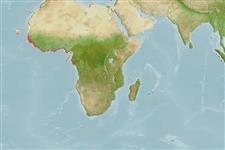Common names from other countries
>
Eupercaria/misc (Various families in series Eupercaria) >
Lethrinidae (Emperors or scavengers) > Lethrininae
Etymology: Lethrinus: Greek, lethrinia, a fish pertaining to genus Pagellus.
More on author: Valenciennes.
Environment: milieu / climate zone / depth range / distribution range
Ecología
marino asociado a arrecife; no migratorio; rango de profundidad 1 - 50 m (Ref. 2683). Tropical; 20°N - 5°S
Eastern Central Atlantic: Senegal to Gabon; also Cape Verde, São Tome-Principe Islands, and Rolas Islands. There is little doubt that only a single species of Lethrinus exists in the tropical western Atlantic.
Length at first maturity / Tamaño / Peso / Age
Maturity: Lm 22.8, range 21 - ? cm
Max length : 50.0 cm TL macho / no sexado; (Ref. 2295); common length : 30.0 cm TL macho / no sexado; (Ref. 2295)
Short description
Claves de identificación | Morfología | Morfometría
Espinas dorsales (total) : 10; Radios blandos dorsales (total) : 9; Espinas anales: 3; Radios blandos anales: 8. The outer surface of the maxilla is smooth, without a knob or pronounced longitudinal ridge. Inner surface of the pectoral fin axil without scales. Overall color is olive green or brown and pinkish. The cheeks have a network of fine reticulations below the eye.
Found in shallow coastal waters (Ref. 2263). Feeds mainly on bottom-dwelling invertebrates. Marketed fresh (Ref. 171), smoked and dried salted (Ref. 2295). Abundant during the winter months (Ref. 2683).
Life cycle and mating behavior
Maturities | Reproducción | Spawnings | Egg(s) | Fecundities | Larva
Carpenter, K.E. and G.R. Allen, 1989. FAO Species Catalogue. Vol. 9. Emperor fishes and large-eye breams of the world (family Lethrinidae). An annotated and illustrated catalogue of lethrinid species known to date. FAO Fish. Synop. 125(9):118 p. Rome: FAO. (Ref. 2295)
IUCN Red List Status (Ref. 130435)
CITES (Ref. 128078)
Not Evaluated
Threat to humans
Harmless
Human uses
Pesquerías: comercial
Herramientas
Special reports
Download XML
Fuentes de Internet
Estimates based on models
Preferred temperature (Ref.
115969): 24.4 - 28, mean 26.6 (based on 60 cells).
Phylogenetic diversity index (Ref.
82804): PD
50 = 0.5000 [Uniqueness, from 0.5 = low to 2.0 = high].
Bayesian length-weight: a=0.01514 (0.00934 - 0.02453), b=2.95 (2.82 - 3.08), in cm Total Length, based on LWR estimates for this species & Genus-body shape (Ref.
93245).
Nivel trófico (Ref.
69278): 3.5 ±0.46 se; based on food items.
Resiliencia (Ref.
120179): Medio, población duplicada en un tiempo mínimo de 1.4-4.4 años (Assuming tm=2).
Fishing Vulnerability (Ref.
59153): Low vulnerability (21 of 100).
Climate Vulnerability (Ref.
125649): High to very high vulnerability (74 of 100).
